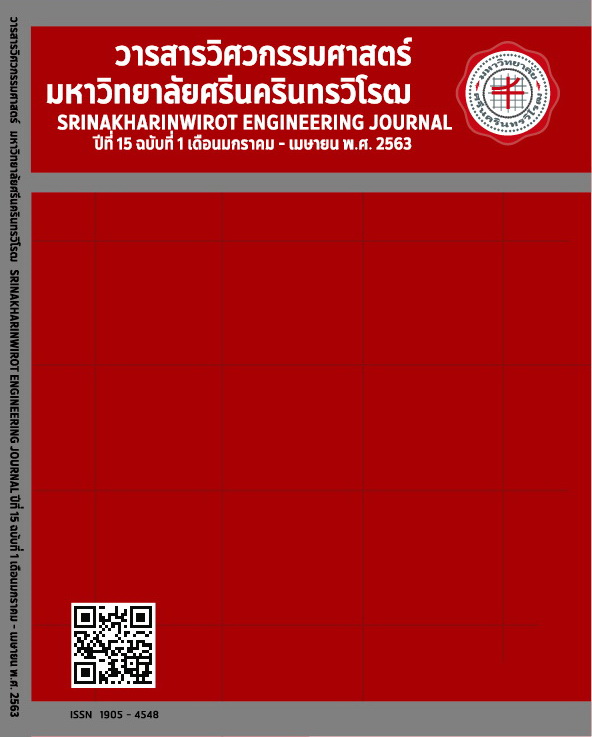Release Kinetic of Riboflavin from Composite Gel Beads Consisting of Alginate Incorporated with Whey Protein or Xanthan Gum
Main Article Content
Abstract
This research aimed to study the release of riboflavin from composite hydrogel beads in simulated gastric fluid (SGF) and simulated intestinal fluid.(SIF) The combinations of gel bead were 100% alginate, 62% alginate and 38% whey protein, 50% alginate and 50% whey protein, 62% alginate and 38% xanthan gum and 50% alginate and 50% xanthan gum. The cross linking solutions were mixtures of calcium chloride with 0%, 0.25% and 0.5% chitosan. The result showed that 100% alginate beads elicited good forming with homogeneous size and shape. Adding whey protein and xanthan gum to alginate improved riboflavin captivation and slow release. Comparison of fitting with 7 release models, release kinetics of the beads could be explained by Higuchi model, Korsmeyer-Peppas model, and Weibull model. The release mechanism was governed by a combination of diffusion and bead erosion.
Article Details
Copyright belongs to Srinakharinwirot University Engineering Journal
References
Q. Ye, N. Georges and C. Selomuya, “Microencapsulation of active ingredients in functional foods: From research stage to commercial food products,” Trends Food Sci. Technol., vol. 78, pp. 167-179. 2018.
C.-C. Lin and A. T. Metters, “Hydrogels in controlled release formulations: Network design and mathematical modeling,” Adv. Drug Deliv. Rev., vol. 58, pp. 1379-1408, 2006.
L. Chen and M. Subirade, “Alginate-whey protein granular microspheres as oral delivery vehicles for bioactive compounds,” Biomaterials, vol. 27, pp. 4646-4654, 2006.
J. Han, A.-S. Guenier, S. Salmieri and M. Lacroix, “Alginate and chitosan functionalization for micronutrient encapsulation,” J Agr. Food Chem., vol. 56, pp. 2528-2535, 2008.
M. Szekalska, K. Sosnowska, A. Zakrzeska, I. Kasacka, A. Lewandowska and K. Winnicka, “The influence of chitosan cross-linking on the properties of alginate microparticles with metformin hydrochloride-In vitro and in vivo evaluation,” Molecules, vol. 22, pp. 1-20, 2017.
S. B. Doherty, M. A. Auty, C. Stanton, R. P. Ross, G. F. Fitzgerald and A. Brodkorb, “Application of whey protein micro-bead coatings for enhanced strength and probiotic protection during fruit juice storage and gastric incubation,” J. Microencapsul., vol. 29, pp. 713-728, 2012.
S. A. Fioramonti, A. A. Perez, E. E. Aringoli, A. C. Rubiolo and L. G. Santiago, “Design and characterization of soluble biopolymer complexes produced by electrostatic self-assembly of a whey protein isolate and sodium alginate,” Food Hydrocoll., vol. 35, pp. 129-136, 2014.
S. Wichchukit, M. H. Oztop, M. J. McCarthy and K. L. McCarthy, “Whey protein/alginate beads as carriers of a bioactive component,” Food Hydrocoll., vol. 33, pp. 66-73, 2013.
L. Chen and M. Subirade, “Effect of preparation conditions on the nutrient release properties of alginate–whey protein granular microspheres,” Eur. J. Pharm. Biopharm., vol. 65, pp. 354-362, 2007.
F. García-Ochoa, V. E. Santos, J. A. Casas and E. Gómez, “Xanthan gum: production, recovery, and properties,” Biotechnol. Adv., vol. 18, pp. 549-579, 2000.
T. Pongjanyakul and S. Puttipipatkhachorn, “Xanthan–alginate composite gel beads: Molecular interaction and in vitro characterization,” Int. J. Pharm., vol. 331, pp. 61-71, 2007.
M. Hamidi, A. Azadi and P. Rafiei, “Hydrogel nanoparticles in drug delivery,” Adv. Drug Deliv. Rev., vol. 60, pp. 1638-1649, 2008.
I. M. Fareez, S. M. Lim, R. K. Mishra and K. Ramasamy, “Chitosan coated alginate-xanthan gum bead enhanced pH and thermotolerance of Lactobacillus plantarum LAB12,” Int. J. Biol. Macromol., vol. 72, pp. 1419-1428, 2015.
P. Costa and J. M. S. Lobo, “Modeling and comparison of dissolution profiles.” Eur. J. Pharm. Sci., vol. 13, pp. 123-133, 2001.
G. Singhvi and M. Singh, “Review: In-vitro drug release characterization models,” Int. J. Pharm. Sci., vol. 2, pp. 77-84, 2011.
S. A. Chime, G. C. Onunkwo nad I. I. Onyishi, “Kinetics and mechanisms of drug release from swellable and non swellable matrices: A review,” Res. J. Pharm. Biol. Chem. Sci., vol. 4, pp. 97-103, 2013.
S. Azadi, H. Ashrafi and A. Azadi, “Mathematical modeling of drug release from swellable polymeric nanoparticles,” J. Appl. Pharm. Sci., vol. 7, pp. 125-133, 2017.
B. A. Harper, S. Barbut, L. T. Lim and M. F. Marcone, “Characterization of ‘wet’ alginate and composite films containing gelatin, whey or soy protein,” Food Res. Int., vol. 52, pp. 452-459, 2013.
D. Conzatti, M. Castel, F. Avadi, S. Cavalie and A. Tourrette, “Alginate/chitosan polyelectrolyte complexes: A comparative study of the influence of the drying step on physicochemical properties,” Carbohydr. Polym., vol. 172, pp. 142–151, 2017.
N. Lal, J. Dubey, P. Gaur, N. Verma and A. Verma, “Chitosan based in situ forming polyelectrolyte complexes: A potential sustained drug delivery polymeric carrier for high dose drugs,” Mater. Sci. Eng. C, vol. 79, pp. 491-498, 2017.
A. Kikuchi, M. Kawabuchi, A. Watanabe, M. Sugihara, Y. Sakurai and T. Okano, “Effect of Ca2+-alginate gel dissolution on release of dextran with different molecular weights,” J. Control. Release, vol. 58, pp. 21-28, 1999.
X. Z. Shu and K. J. Zhu, “The release behavior of brilliant blue from calcium-alginate gel beads coated by chitosan: the preparation method effect,” Eur. J. Pharm. Biopharm., vol. 53, pp. 193-201, 2002.
M. A. Mujtaba, K. A. M. Hassan and M. Imran, “Chitosan-alginate nanoparticles as a novel drug delivery system for rutin,” Int. J. Adv. Biotechnol. Res., vol. 9, pp. 1895-1903, 2018.
J. L. C. De Queiroz, R. O. De Araújo Costa, L. L. R. Matias, A. F. De Medeiros, A. F. T. Gomes, T. Dos Santos Pias, T. S. Passos, B. L. L. Maciel, E. A. Dos Santos and A. H. De Araújo Morais, “Chitosan-whey protein nanoparticles improve encapsulation efficiency and stability of a trypsin inhibitor isolated from Tamarindus indica L,” Food Hydrocoll., vol. 84, pp. 247-256, 2018.
I. M. Fareez, S. M. Lim, R. K. Mishra and K. Ramasamy, “Chitosan coated alginate-xanthan gum bead enhanced pH and thermotolerance of Lactobacillus plantarum LAB 12,” Int. J. Biol. Macromol., vol. 72, pp. 1419-1428, 2015.
S. Argin-Soysal, P. Kofinas and Y. M. Lo, “Effect of complexation conditions on xanthan–chitosan polyelectrolyte complex gels,” Food Hydrocoll., vol. 23, pp. 202-209, 2009.


